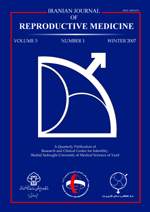
|
International Journal of Reproductive BioMedicine
Research and Clinical Center for Infertility, Shahid Sadoughi University of Medical Sciences of Yazd
ISSN: 1680-6433
EISSN: 1680-6433
Vol. 19, No. 11, 2021, pp. 951-958
|
 Bioline Code: rm21098
Bioline Code: rm21098
Full paper language: English
Document type: Research Article
Document available free of charge
|
|
|
International Journal of Reproductive BioMedicine, Vol. 19, No. 11, 2021, pp. 951-958
| en |
Sequence analysis reveals asymptomatic infection with Mycoplasma hominis  and Ureaplasma urealyticum and Ureaplasma urealyticum  possibly leads to infertility in females: A cross-sectional study possibly leads to infertility in females: A cross-sectional study
Ezeanya-Bakpa, Chinyere Charity; Agbakoba, Nneka Regina; Oguejiofor, Charolette Blanche & Enweani-Nwokelo, Ifeoma Bessie
Abstract
Background: Genetic evidence of asymptomatic Mycoplasma hominis (M. hominis)
and Ureaplasma urealyticum (U. urealyticum) infection associated with infertility among
females is lacking because suitable high throughput molecular
methods have not been
applied.
Objective: This study aimed to explore the occurrence of M. hominis and U. urealyticum
in the genital tract of females with asymptomatic infection and infertility as well as
determine their genetic relatedness.
Materials and Methods: The study group included 100 asymptomatic females and 31
females diagnosed with infertility. Sequencing of the 16S rRNA gene following DNA
extraction was performed directly from endo-cervical swabs. Phylogenetic analysis
established the genetic linkage between the isolates from both groups.
Results: In asymptomatic females, M. hominis and U. urealyticum were detected with
a prevalence of 8% and 2% respectively. Among females with infertility, the prevalence
was 6.45% and 3.23% for M. hominis and U. urealyticum respectively. In both groups,
M. hominis occurred significantly more frequently. Phylogenetic analysis revealed
three distinct clusters in both groups: two with already characterized M. hominis and
Ureaplasma species (28.6% of the overall Mycoplasma spp.) and one distinct cluster
matched with U. urealyticum. Furthermore, all M. hominis from asymptomatic females
clustered significantly with infertility contrary to U. urealyticum. The M. hominis cluster
was significantly linked to two strains from China.
Conclusion: The sequence analysis of Mycoplasma and Ureaplasma in the genital
tract of asymptomatic and infertile females showed significant association; therefore,
it is paramount to consider them as possible etiologic agents of infertility and genital
infection, especially when the etiology of infertility is unknown.
Keywords
Mycoplasma hominis; Ureaplasma urealyticum; Genetic linkage; Asymptomatic infections; Infertility.
|
| |
© Copyright 2021 - International Journal of Reproductive BioMedicine
Alternative site location: http://www.ijrm.ir
|
|
